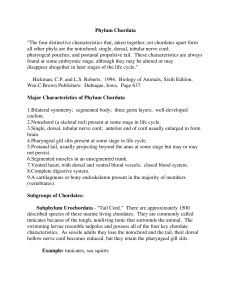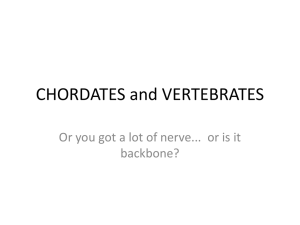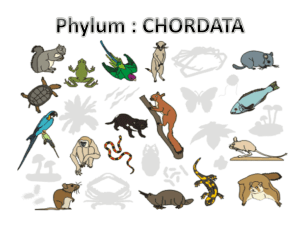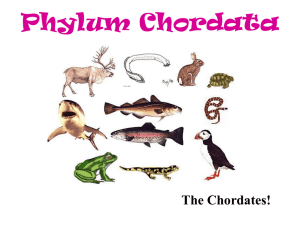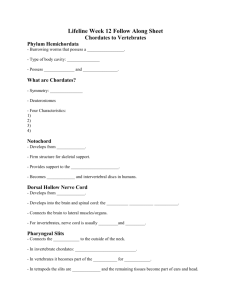Phylum Chordata
advertisement
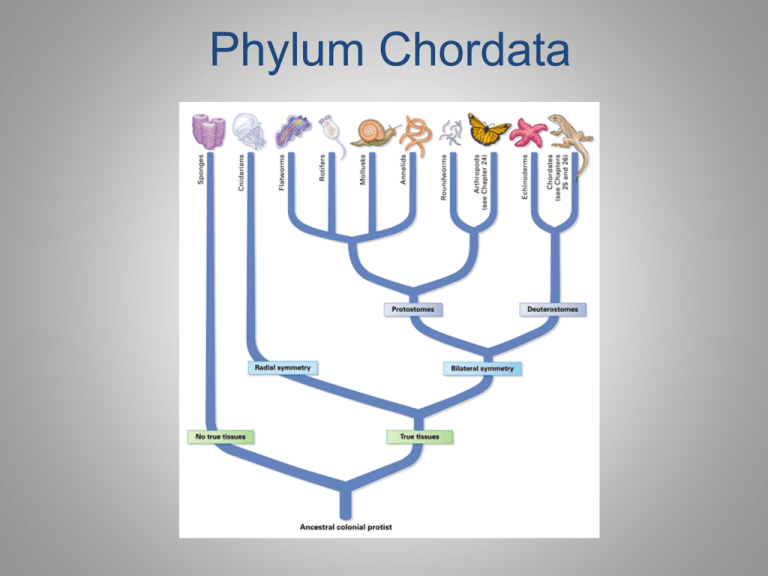
Phylum Chordata Taxonomy • Phylum Chordata – Subphylum Cephalochordata- amphioxus or lancelet – Subphylum Urochordata- tunicates or sea squirts – Subphylum Vertebrata • Class Agnatha- jawless and cartilaginous, hagfish and lamprey • Class Chondrichthyes- cartilaginous, sharks and rays Fish • Class Osteichthyes- bony fish Cold • Class Amphibia- cecilians, salamanders, frogs, toads Blooded (Ectotherm) • Class Reptilia- snakes, lizards, turtles, tortoises, alligators, crocodiles, tuataras • Class Aves- birds Warm Blooded • Class Mammalia- dogs, cats, lions, horses, cows, bears, (Endotherm) giraffes, elephants, monkeys, kangaroos, humans, platypus, mice, beavers, seals, sea lions, walruses, whales, dolphins, porpoises, manatees, dugongs, anteaters, armadillos, sloths, bats, shrews, moles, hedgehogs… 18 ft. Oarfish Characteristics of Chordates • • • Dorsal notochord ~ rod of tough, flexible tissue running the length of the animal’s body and serving as its primary support. *In most chordates, notochord is replaced by vertebrae before birth or hatching. Vertebrae ~ composed of either a tough flexible material (cartilage) or bone Vertebral column ~ all the vertebrae together. Characteristics of Chordates • Dorsal tubular nerve cord ~ located dorsal to the notochord or vert. column. The nerve cord and brain, which is attached to the anterior end of the cord, compose the main part of the nervous system. *the vertebrae may encase the nerve cord to protect it. Characteristics of Chordates Pharyngeal pouches ~ are present during embryonic development. Are folds of skin along the neck. – – In aquatic organisms openings develop at the pouches. Allow water flow over gills. Non aquatic organisms ~ pouches develop into structures located in the lower face, neck and upper chest region. Subphylums Cephalochordata ~ Aquatic, have notochords entire lives. Amphioxus or lancelet, typical cephalochordate, eel-like creature, about 2 inches long. Subphylums Urochordata ~ have notochords in larval stage. Tunicates or sea squirts ~ typical urochordate, pump water through small pores on their bodies. Tadpoles of these animals have all three of the characteristics of chordates, but lose all but pharyngeal slits as adults. Subphylums Vertebrata ~ contains animals with backbones. Vertebrates live in virtually every habitat from the ocean floor to the upper fringes of the atmosphere. 95% of Chordates are Vertebrates. Great variety within subphylum. Vertebrata Classes Seven classes of Subphylum Vertebrata: First five are Ectothermic ~ cold-blooded, does not have the ability to generate its own body heat or maintain a constant body temp. above its surroundings. Depends on heat from other sources to stay alive: 1. Agnatha ~ jawless fish, lack bone or paired fins. Examples are lamprey and hagfish 2. Chondrichthyes ~ cartilaginous skeleton, paired fins. Examples are sharks, skates and rays. 3. Osteichthyes ~ fish with bony skeleton. Examples are bass, perch, trout. 4. Amphibia ~ lay eggs in water, have aquatic larval stage. Examples are frogs, toads and salamanders. 5. Reptilia ~ dry scaly skin, amniotic egg, internal fertilization. Examples are turtles, snakes and alligators. Vertebrate Classes Endothermic ~ warm-blooded, generate their own body hear to maintain body temp. within a narrow range. May burn 30 times as much energy as an ectothermic animal of the same weight. 6. Aves ~ hollow bones, flying feathers. Examples are any bird, flamingo, penguin, robin, etc. 7. Mammalia ~ hair, nurse young with milk. Examples are dogs lions and humans. Support and Movement Endoskeleton ~ internal skeleton that vertebrates have. Functions/Characteristics: surround, protect and support delicate organs Movement occurs due to muscles that cover bones. Permits greater freedom of movement than an exoskeleton Much lighter than an exoskeleton Two divisions of skeleton Axial ~ consists of vertebral column, skull, and ribs Appendicular ~ composed of girdles and limb bones Two girdles A. Pectoral ~ the anterior region B. Pelvic ~ posterior Circulation and Excretion Vertebrates have a closed circulatory system, which means the blood stays within the blood vessels during its journey through the body. Contains : 1. Heart, which can have 2-4 chambers 2. Blood vessels Three types: A. Arteries ~ carry blood away from the heart to body tissues. Highly oxygenated. B. Capillaries - terminal branches of the arteries. Thinwalled vessels that pass through body tissues, that supply tissues with nutrients and oxygen and remove wastes and carbon dioxide from tissues. C. Veins ~ begin in capillaries and carry blood from body tissues back to the heart. Very low in oxygen, high in wastes. Hemoglobin ~ red, iron containing, oxygen-carrying pigment present in red blood cells. Kidneys ~ filter out wastes carried by the blood stream. Nutrition Feeding methods of vertebrates: 1. Carnivorous ~ animals feed upon other animals. Have sharp teeth, claws or other specialized structures to help with process. 2. Herbivorous ~ animals eat plants. Have grinding teeth to breakdown cellulose of plants, and often bacteria in digestive tract to aid process. 3. Omnivorous ~ eat both plants and animals. Have a variety of teeth to aid in eating both. Alimentary canal ~ composed of an esophagus, stomach and intestines. With the liver, gallbladder and pancreas as accessory organs. Composes the digestive system of vertebrates. Reproduction In most vertebrates, the sexes are separate. Males ~ have paired testes that produce sperm Females ~ have paired ovaries that produce eggs. Methods of fertilization 1. External ~ male fertilizes the eggs by releasing sperm onto them after the female lays them. Takes place in water, and eggs have no shell. 2. Internal ~ male places the sperm inside the female’s body where the eggs are fertilized. Three basic methods of embryo development: 1. Oviparous ~ produce offspring from eggs that hatch outside the body. 2. Viviparous ~ produce live offspring that have been nurtured to birth inside the uterus or similar structure in the mother. 3. Ovoviviparous ~ organisms produce live offspring that were not nurtured through a direct connection to the mother. The fertilized egg often with a shell, remain in the mother’s body and hatch there. Benefit for egg because of the more constant body temperature of the mom. Nervous system contains: 1. Brain 2. Spinal cord 3. Cranial nerves (branch from the brain) 4. Spinal nerves (branch from the spinal cord) 5. Sensory organs( eyes, ears, taste buds) Divisions of the Five major lobes of the brain, from anterior to posterior: 1. Olfactory lobes ~ receive impulses from the smell receptors of the nostrils 2. Cerebrum ~ controls voluntary muscle activity 3. Optic lobes ~ Receives impulses from the eyes 4. Cerebellum ~ coordinates muscle activity and some involuntary activities 5. Medulla oblongata ~ transports impulses to and from the spinal cord, including some reflexes. Nervous System Vertebrate Behavior Behavior ~ the way an animal responds to its environment. Three types of vertebrate behavior: 1. Inborn behavior (innate behavior) ~ behavior that the organism has from birth and does not need to develop. A. B. Reflex behavior ~ automatic, involuntary response to a stimulus. Examples: blinking and recoiling from pain Instinct behavior ~ elaborate behaviors, apparently the result of a stimulus or series of stimuli. Examples: salmon returning to birthplace, mating rituals, self-preservation 2. Conditioned behavior (learned behavior) ~ response learned by experience. Examples: spraying by skunk, eating something bitter or toxic, training. Modeling ~ learning important behaviors by watching others of their species. 3. Intelligent behavior ~ the ability to use knowledge to manipulate the environment or the ability to communicate, which can be instinctive or learned. Examples: chimps using stones to crack open nuts, twigs to fish out termite mounds, woodpecker finch using cactus spine to dig out grubs.

